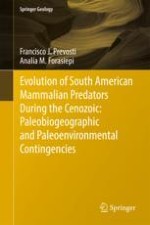2018 | OriginalPaper | Chapter
6. Evolution and Biological Context of South American Mammalian Carnivores During the Cenozoic and the Biological Context
Authors : Dr. Francisco Juan Prevosti, Dr. Analia M. Forasiepi
Published in: Evolution of South American Mammalian Predators During the Cenozoic: Paleobiogeographic and Paleoenvironmental Contingencies
Publisher: Springer International Publishing
Activate our intelligent search to find suitable subject content or patents.
Select sections of text to find matching patents with Artificial Intelligence. powered by
Select sections of text to find additional relevant content using AI-assisted search. powered by
